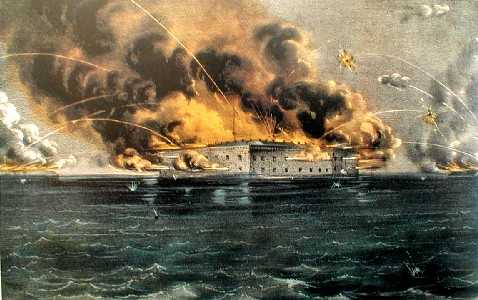Mood:
Now Playing: Bluegrass Radio
Topic: Real War
052018AUG05
"Why, it appears that we appointed all of our worst generals to command the armies and we appointed all of our best generals to edit the newspapers. I mean, I found by reading a newspaper that these editor generals saw all of the defects plainly from the start but didn't tell me until it was too late. I'm willing to yield my place to these best generals and I'll do my best for the cause by editing a newspaper.” --Robert E. Lee
The legacy of two wars now dominates the future of the War on Terror. One of the two should be manifestly clear: the Vietnam War. That war, the sin quo non of military history for the Left, has been thoroughly explained, analyzed, and interpreted by this pundit as well as many others. However, another war, one whose influence is just as palpable as that of the Vietnam ghost, has, thus far, gone without comment. The war of which I speak is the first war against Iraq---Gulf War One (a.k.a. Desert Storm).
Why do I consider this smashing victory of 1991 as so influential? Because it set America’s expectation of what a modern, high-tech warfare can deliver way too high.
Desert Storm was a remarkably clean war after our nation’s gritty experience in South East Asia. To start, it was every United Nations aficionado’s dream come true: 34 separate nations, united under U.N. auspices, cooperating to expel the Butcher of Baghdad from Kuwait. It was seen as a ray of hope, after a long, divisive Cold War, that a turbulent globe could join hands and work for the greater good of mankind---in this case, undoing a manifest wrong against the Kuwaiti people. Furthermore, this international cooperation also helped bolster America’s resolve. We were not ‘going it alone’, but could count on the support of a vast community of nations, even Middle Eastern states that, heretofore, were less than eager to assist any Western military operation.
Better, the actual military operations were just as encouraging. After hearing dire predictions from the experts, vis-a-vis the robust size and capabilities of the Iraqi military, the actual armed confrontation was almost anti-climatic. America began the war with a four week air assault, the size and complexity of which had not been seen since World War Two. Glitzy Cold War-era technology served to guide smart munitions to their targets with pinpoint accuracy. American’s could watch, with rapt attention, missiles and bombs attacking targets through windows and air shafts---from the weapon’s point of view, no less! The Iraqi military forces and command centers were quickly shattered with few loses to air personnel.
After the drubbing from the air, America sent in our vaunted armor and infantry forces. This was when everyone really held their breath---after all, America had not had to face a large ground war for over two decades. And not since World War Two had we faced an enemy so well endowed with tanks and armored vehicles of their own. Would the unproven M1 Abrams tank hold its own against the Iraqi owned and operated Soviet equipment? The answer was a resounding “yes!” After only 100 hours of direct combat, America’s “boots on the ground” had decisively bested their Iraqi foe, smashing even the vaunted Republican Guard formations that held much of Saddam’s neighbors in a state of perpetual fear.
America had won a victory of epic proportions, and all in less than two months worth of combat time. Even better, U.S. casualties were miraculous: 148 killed, with a sizeable percentage of that due to “friendly fire” incidents. It would seem America had rewritten the rule book on warfare.
And therein lays the problem.
Because of Desert Storm, the average American has come to demand that every war achieve the lofty heights of perfection set by Gulf War One. If victory is not achieved in 100 hours or less, if American ground casualties mount beyond 148, if a huge body of the world politic does not cheer us on, well, then, clearly defeat must be just around the corner, no?
This attitude is proving poisonous to our efforts in Iraq and must be overcome.
Americans must be given a crash-course in military history. They must be made aware that every war is different, each with its own peculiar set of conditions, its own standards of victory. The glorious radiance of Desert Storm must not be allowed to blind us to the fact that that war was the exception, not the rule. Wars, even American wars, have been bloody, tiring affairs. Consider the following:
During the Revolutionary War, total American deaths are estimated to be in the range of 6,824 over a period of eight years. America suffered over 400 killed in action at the Battle of Bunker Hill alone, a fight lasting a few hours.
During the War of 1812, this nation’s original ‘forgotten war’, we suffered 2,260 deaths and an additional 4,505 injured from 1812 to 1815.
Our brief, two year war with Mexico (1846-1848) generated 1,733 dead and another 4,152 wounded.
With the American Civil War, the victims really start piling up. From 1861 to 1865, America sustained a staggering 610,000 (360,000 Union, 250,000 Confederate) dead, with total casualties at 1.1 million! During the Battle of Antietam, the bloodiest single day in U.S. history, both sides suffered a combined 23,000 casualties. At the later Battle of Gettysburg, both sides endured 53,000 dead and wounded during the course of a three day battle!
The single-year Spanish American War (1898) resulted in 2,446 deaths, and 5,500 wounded soldiers. All that for one year….
The 20th Century would set new records for costly martial contests:
World War One (U.S. involvement: 1917-1918): 126,000 killed in action, 234,300 wounded.
World War Two (U.S. involvement: 1941-1945): 405,500 dead, 671,750 wounded. One D-Day alone (June 6, 1944), we lost 1,465 dead and 3,184 wounded. With the surprise attack now known as the Battle of the Bulge (December 16, 1944 to January 25, 1945), America suffered another 19,000 dead, and 38,446 wounded.
Korea (1950-1953): 36,934 dead and 103,284 wounded.
Vietnam (U.S. involvement: 1965-1975): 47, 378 killed in action, 10,799 wounded.
This is surely a grim list. It is interesting to note that as the technology of war became more sophisticated, the death toll increased accordingly. This fact teaches a lesson that stands against our experiences with Desert Storm: high technology is not a cure-all for the carnage of the battlefield.
In light of these figures, how does the fight in Iraq compare?
Operation: Iraqi Freedom (as of August 2005): American deaths number 1,830 since March of 2003. Total wounded is a higher figure at 13,769.
In comparison to our historic experiences for other major wars, our losses have been exceptionally light---that’s right, I’ll repeat it again: exceptionally light. Considering that America is fighting a war for over two years, one involving at least two fronts (i.e., against terrorists trained and equipped by both Syria and Iran), we have managed to deal far more death than we have received (thank God!). Even better, despite our enemy’s ruthless efforts, we have succeeded in creating the first freely elected, soon-to-be constitutional government in that region!
Of course, if you listen to the popular pundits, many of whom only can view our successes through a Vietnam-Desert Storm prism, we are failing miserably. They daily count off the American dead with the precision of an atomic clock (of course, never bothering to mention enemy casualties and setbacks), and demand to know why our troops have not squelched all armed opposition. What a sorry, pessimistic sham.
This is a real war, people!
We are facing an enemy just as determined to win as we are. Worse, we are fighting a foe that is desperate, with his back against the wall, for if the United States succeeds in creating a liberal democracy in Iraq, the very real end of Islamo-fascism will soon be seen on the horizon. Just as the mere existence of a free West Germany served to undermine the East German totalitarian rulers, an Iraq conceived in liberty will also serve to pull the rug out from under the mad mullahs of the Middle East.
Another thing: don’t let the words “terrorist” and “insurgent” confuse you. We are not fighting the orient’s equivalent of minutemen--- farmers armed with muskets. The people we are fighting are some of the best equipped and trained soldiers that the despotic regimes of Syria and Iran can muster (in addition to renegade Ba’athists). These are the shock troops of such bloody organizations as Hizballah and Ansar al-Islam---paramilitary organizations with extensive experience in maiming and killing. These guys might not wear a uniform, but they are as capable as any army that has ever marched under a national flag.
America must reacquaint itself with real war. This struggle has far less similarity to the quick and painless Desert Storm than it does with the titanic and bloody American Civil War and World War Two. There is no magic bullet, no amount of troops, no single weapon, which will prove a cure-all for enemy resistance. Just as the massive, armed might of General Eisenhower’s forces could not stop a determined Hitler from launching the Ardennes Offensive, there is nothing Iraq’s commanding general, George Casey, can do to win this struggle overnight. We must learn from the past. Abraham Lincoln, along with the soldier-hero of the Union, General Ulysses S. Grant, understood that the sole path to victory against the Confederacy was unceasing offensive operations until the rebels cracked. This strategy is appropriate for the War on Terror as well. President Bush and Secretary of Defense Donald Rumsfeld understand that the enemy will never cease until they are smashed in detail. Battles will be fought, casualties will mount on both sides, but if we hold firm to our just cause, we will prevail. It will take time, it will not be easy, but, with God on our side, and the unceasing support of the American people for their fighting men and women at the front, we will succeed. And that is the sole formula for victory.









